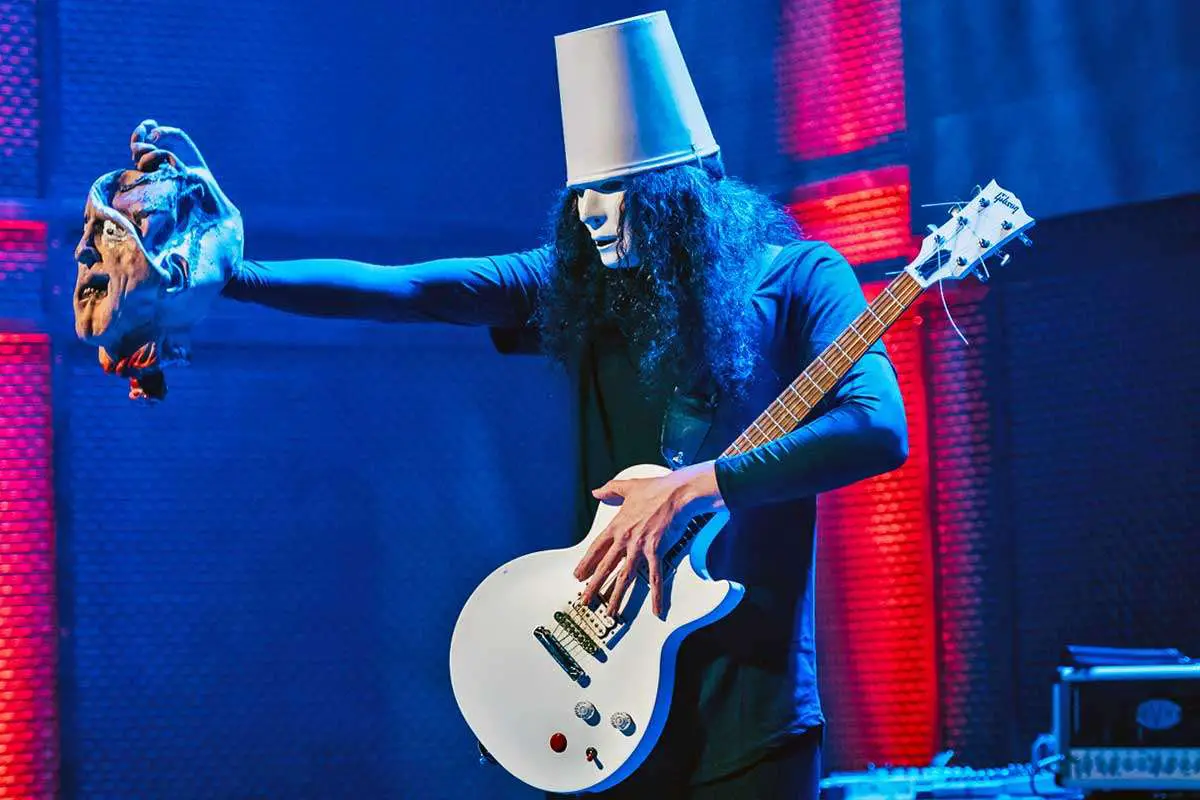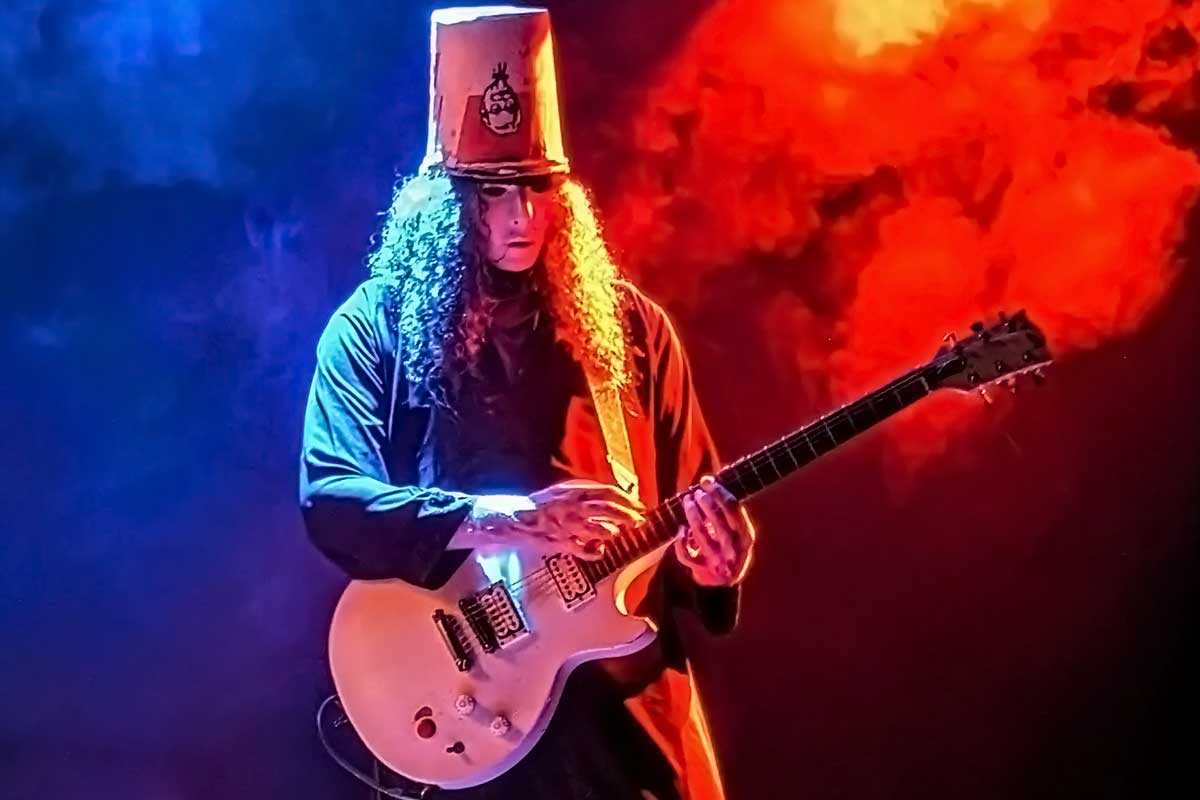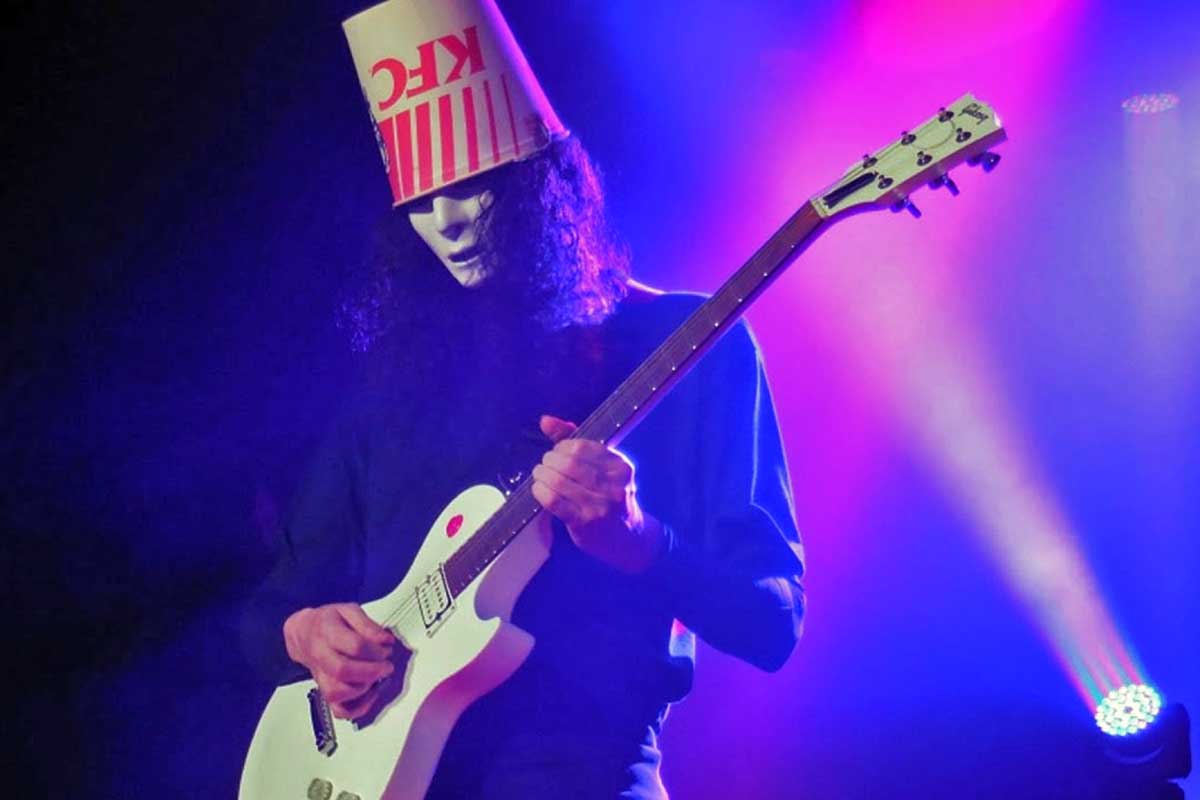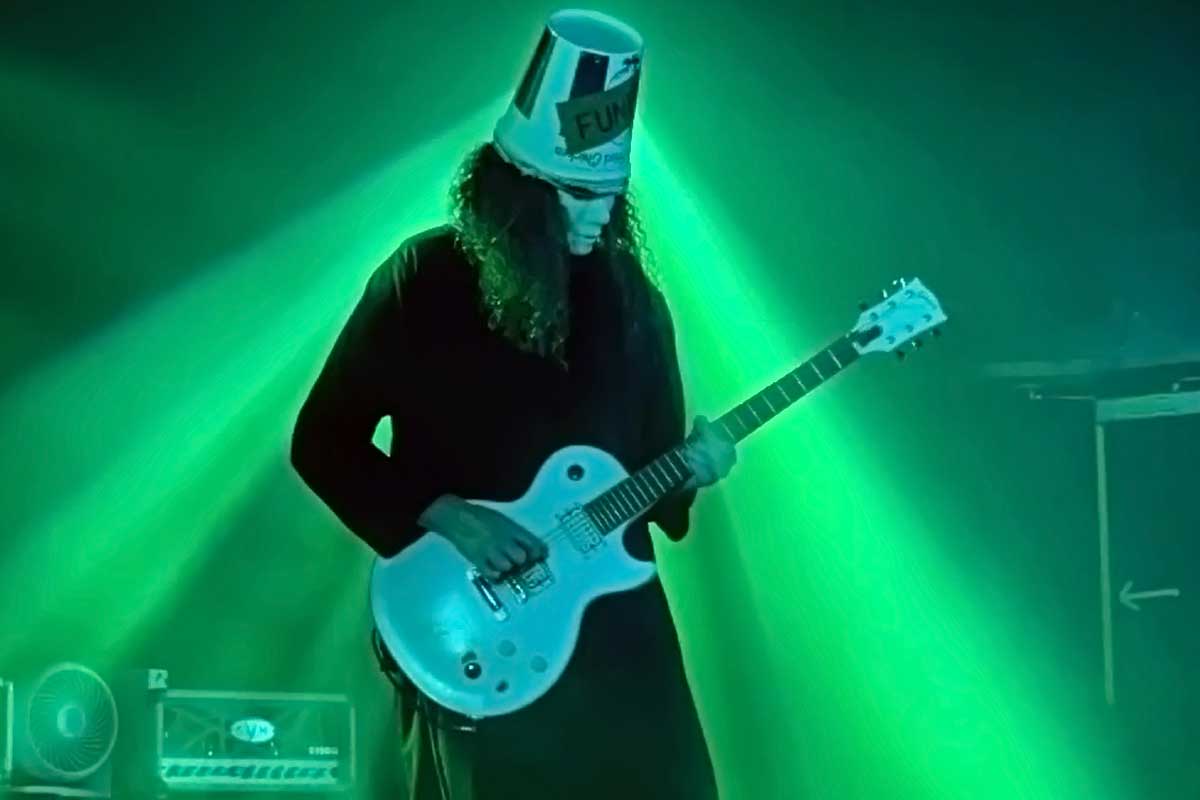Brian Patrick Carroll, better known by his stage name Buckethead, is a figure shrouded in mystique within the music world. His signature look, complete with an expressionless white mask and a KFC bucket hat, has famously concealed his true identity for the majority of his career. The avant-garde musician is revered for his extraordinary guitar skills and eclectic range of musical genres, spanning from progressive metal to ambient and even incorporating elements of funk.
Despite his unorthodox stage presence and enigmatic persona, rare glimpses of Buckethead without his mask have surfaced, revealing the man behind the mask to the public. These instances have peeled back a layer of the mystery surrounding him, providing insight into the individual who has crafted such an unusual and compelling character.
The curiosity around Buckethead’s identity extends beyond mere appearance; fans are fascinated by his personal history and the influences that shaped his unique approach to music and performance. Born on May 13, 1969, Carroll developed an affinity for Disneyland and a passion for martial arts movies, which would later manifest in his theatrical stage presence and storytelling through music.

Background
Many have speculated on the true face behind the enigmatic performer known as Buckethead. Images have circulated online showing a tall, long-haired individual said to be Buckethead without his mask, in the company of renowned musicians. Despite the visual resemblances and the presence of esteemed guitarists such as Paul Gilbert, these photos have been misattributed to the French guitarist Stephane Alaux, who humorously engages with the mix-up on his website. Concerted efforts to unveil the mystery often overlook the distinct playing techniques and physical characteristics that set Buckethead apart from his supposed look-alike.
Validation of Buckethead’s identity comes from various reputable sources that provide credible evidence of his real name, Brian Carroll. Not only has his musicianship been documented under his birth name, but also endorsements and recollections from high-profile artists such as Ozzy Osbourne authenticate the name Brian as being connected to the artist. Beyond this, shared personal history, influences, and family details further solidify the connection, affording a glimpse into the person behind the mask and ensuring his legacy remains tied to his personal identity and family heritage.
Related: Max Norman: The Ozzy Producer Behind Heavy Metal’s Defining Records
Public Appearances
On the rare occasions that Brian Carroll has stepped out without his signature mask and KFC bucket, fans have had the opportunity to see the musician in a more personal light. The few verified photographs of Carroll unmasked capture him in candid moments, most prominently during early points in his career, particularly as seen in footage from the “Young Buckethead” DVDs. Despite the secretive nature of his persona, these instances provide a glimpse into the man behind the mask, solidifying his status as a prolific guitarist separate from his enigmatic Buckethead character.
Brian Carroll Buckethead Unmasked?
The Buckethead persona is both enigmatic and iconic, defined largely by the white mask and the KFC bucket that adorn his head. These distinctive features have been part of his identity throughout his career in the music industry.
Key Takeaways
- Stephane Alaux, known as Fanalo, is often mistaken for Buckethead but humorously denies the claims with evident differences in playing technique.
- Credible sources confirm that Buckethead’s real name is Brian Carroll, as attested by historical records and public acknowledgments within the music industry.
- References to family and personal history in Carroll’s music and official releases strengthen the recognition of his identity and influences.
References & Identity Characteristics
Photographs have circulated online showing an individual, claimed by some to be Buckethead, in company with renowned guitarists such as Joe Satriani and Paul Gilbert. This individual is of a tall stature with long hair, reminiscent of Buckethead’s silhouette, hence the mix-up. Notably, one photograph includes the French guitarist Stéphane Alaux, also known by his stage name, Fanalo, who jestingly acknowledges the confusion on his own website. Despite his tongue-in-cheek concession that he is Buckethead, differences in their guitar playing technique, notably the pinkie finger and pick usage, point otherwise.
Identifying Characteristics:
- Technique: Distinct style and finger positioning contrasts with Buckethead’s.
- Signature Traits: Absence of a prominent vein in the right hand that fans associate with Buckethead.
Concerning the true identity of Buckethead, evidence solidifies Brian Carroll as the man behind the mask. Details from various respected sources like MTV, Ozzy Osbourne, and a 1989 guitar magazine advertisement, where Carroll’s personal statement matches with Buckethead’s known history, cement this identity. The ad further supports this with a listed age of 20 in 1989, suggesting a 1969 birth year.
Documented References:
- Guitar Magazine (Dec 1989): Ad listing Brian Carroll and his age, links to Buckethead.
- Known Affiliates: Mentions of relations with Paul Gilbert.
- Public Recordings and Interviews: Consistencies in influences, life events, and personal acknowledgments.
Visual evidence from the ‘Secret Recipe’ DVD and family-released images on important dates, such as an image on May 13th, 2013, Buckethead’s likely birth date, further authenticate Buckethead’s real-life persona.

Visual Evidence:
- Residency: Features of a family home recurring in official materials.
- Birth Date: Coincidental album and photo releases on May 13th, a potential birthday.
Ultimately, the search for Buckethead’s identity has led to spectral evidence, most notably from the ‘Coming Alive’ podcast and the visible acknowledgment of his family’s influence in his work, especially demonstrated in tributes to his late parents. Former footage adds to this puzzle, linking style nuances to Buckethead.
Influence and Legacy:
- Emotional Tributes:
- Albums ‘Hold Me Forever’ and ‘Heaven Is Your Home’.
- Songs ‘For Mom’ and ‘Watching the Boats with my Dad’.
- Podcast Interview: Authenticity of in-character revelations confirmed by close associates.
Debunking impersonation claims while respecting the rich anonymity that defines the virtuoso performer, the intrigue surrounding Buckethead remains a respectful nod to his artistry and personal narrative concealed behind the mask.

Behind the Bucket: Brian Carroll’s Journey from Mystery to Music Icon
Guitar enthusiasts intrigued by the phenomenon of a certain masked musician may find themselves searching for images of “Buckethead unmasked.” Often, they come across pictures featuring a tall, long-haired individual alongside renowned guitarists such as Joe Satriani, and Steve Vai, including affiliations with Paul Gilbert and Shawn Lane. This figure is not Buckethead but a French guitarist, Stephane Alaux, also known as Fanalo. He playfully acknowledges on his site the ongoing mix-up due to their resembling appearances, humorously conceding to claims of being Buckethead in a sarcastic tone. Fans of Buckethead, however, note stylistic and physical differences, particularly in Fanalo’s finger and pick positioning – which noticeably diverges from Buckethead’s technique – and a distinct vein in Buckethead’s hand that Fanalo lacks.
The true identity of the man behind the bucket has been substantiated through various sources. A December 1989 magazine advertisement attributed to the artist names him as Brian Carroll. Confirmation of Buckethead’s birth name emerged from a 2017 interview on the podcast ‘Coming Alive’ and was corroborated by a 2002 MTV article as well as a recollection from Ozzy Osbourne during a 2005 interview with Revolver Magazine. These sources, alongside writing credits under the name Brian Carroll on Guns N Roses‘ ‘Chinese Democracy’ album, cement his identity.
Related: What Guitars Does Slash Play
The ad mentioned earlier also provides insight into Carroll’s age, listing him as 20 years old in 1989, which implies his birth year as 1969. While his exact birthday remains somewhat elusive, clues point to a high probability that it falls on May 13th. His influences are listed within the ad, including Michael Jackson and his distinguished teachers, one of which is Paul Gilbert, who played a significant role in his development as a guitarist. Personal accounts from Carroll express gratitude for the guidance received and hint at his endeavors in making demo recordings to showcase his playing and writing styles.

Confirmatory details about his familial ties and home are gained through a visual backdrop found in an image believed to be sent by Carroll himself and through a video excerpt from his official release ‘Binge Clips.’ These sources show repeated imagery of a house likely belonging to the Carroll family. It is inferred that Brian Carroll grew up in a home resonant with memories and personal history that is also reflected in his DVD ‘Secret Recipe.’
Moreover, his father, Thomas Manley Carroll’s influence, as well as that of his mother Nancy Carroll, continue to echo in Carroll’s music, with albums and songs dedicated to them. This is evident in titles like ‘Hold Me Forever’ and ‘Heaven is your home’—tributes that underscore their pivotal impact on his life and artistry. A family profile presented in Daily Bulletin following Tom Carroll’s demise in May 2014 mentions Carroll as one of five siblings, further illuminating the family dynamic.
Footage from 1988 has surfaced possibly showing a young Brian Carroll in a band known as ‘Class-X.’ Despite uncertain authenticity and scant details about the band, the playing style observed aligns with characteristics familiar to fans of Buckethead. Lastly, an interview in 2017 on the ‘Coming Alive’ podcast gave fans a rare glimpse into the person beneath the persona. While some listeners expressed skepticism, corroborative statements from respected sources within the entertainment industry, as well as his friends and colleagues, lend legitimacy to the content of the interview.
